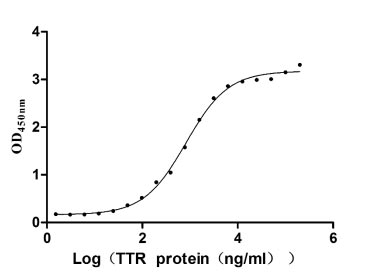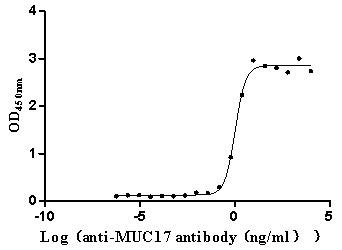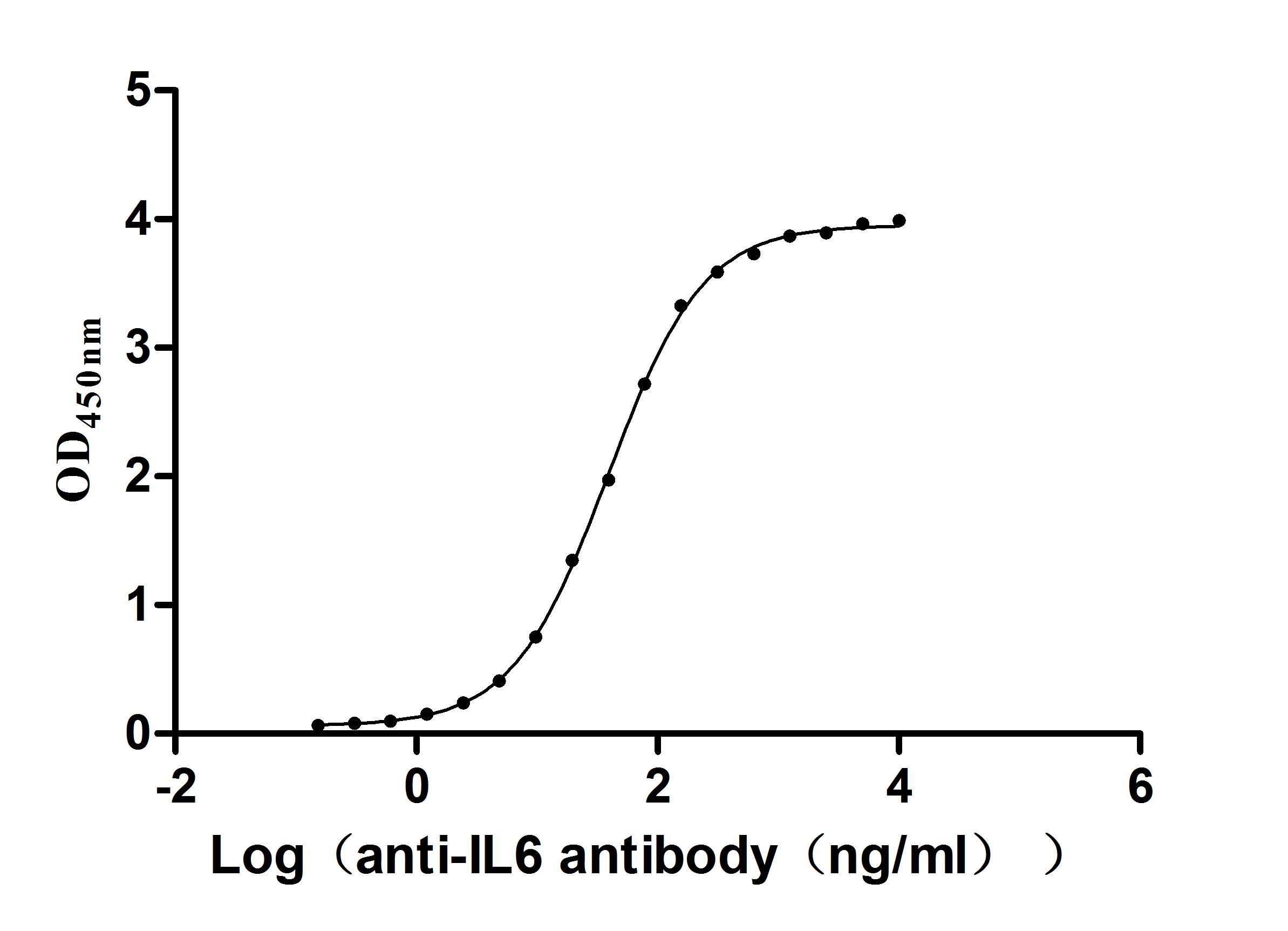Recombinant Human Leucine-rich glioma-inactivated protein 1 (LGI1)
-
货号:CSB-BP012898HU
-
规格:
-
来源:Baculovirus
-
其他:
-
货号:CSB-EP012898HU-B
-
规格:
-
来源:E.coli
-
共轭:Avi-tag Biotinylated
E. coli biotin ligase (BirA) is highly specific in covalently attaching biotin to the 15 amino acid AviTag peptide. This recombinant protein was biotinylated in vivo by AviTag-BirA technology, which method is BriA catalyzes amide linkage between the biotin and the specific lysine of the AviTag.
-
其他:
-
货号:CSB-MP012898HU
-
规格:
-
来源:Mammalian cell
-
其他:
产品详情
-
纯度:>85% (SDS-PAGE)
-
基因名:
-
Uniprot No.:
-
别名:ADLTE; ADPAEF; ADPEAF; Epitempin 1; EPITEMPIN; Epitempin-1; EPT; ETL1; IB1099; leucine rich glioma inactivated 1; Leucine rich glioma-inactivated protein 1; Leucine-rich glioma-inactivated protein 1; LGI1; LGI1_HUMAN; OTTHUMP00000020121; OTTHUMP00000020122
-
种属:Homo sapiens (Human)
-
蛋白长度:Full Length of Mature Protein
-
表达区域:35-557
-
氨基酸序列KKPAKP KCPAVCTCTK DNALCENARS IPRTVPPDVI SLSFVRSGFT EISEGSFLFT PSLQLLLFTS NSFDVISDDA FIGLPHLEYL FIENNNIKSI SRHTFRGLKS LIHLSLANNN LQTLPKDIFK GLDSLTNVDL RGNSFNCDCK LKWLVEWLGH TNATVEDIYC EGPPEYKKRK INSLSSKDFD CIITEFAKSQ DLPYQSLSID TFSYLNDEYV VIAQPFTGKC IFLEWDHVEK TFRNYDNITG TSTVVCKPIV IETQLYVIVA QLFGGSHIYK RDSFANKFIK IQDIEILKIR KPNDIETFKI ENNWYFVVAD SSKAGFTTIY KWNGNGFYSH QSLHAWYRDT DVEYLEIVRT PQTLRTPHLI LSSSSQRPVI YQWNKATQLF TNQTDIPNME DVYAVKHFSV KGDVYICLTR FIGDSKVMKW GGSSFQDIQR MPSRGSMVFQ PLQINNYQYA ILGSDYSFTQ VYNWDAEKAK FVKFQELNVQ APRSFTHVSI NKRNFLFASS FKGNTQIYKH VIVDLSA
-
蛋白标签:Tag type will be determined during the manufacturing process.
The tag type will be determined during production process. If you have specified tag type, please tell us and we will develop the specified tag preferentially. -
产品提供形式:Lyophilized powder
Note: We will preferentially ship the format that we have in stock, however, if you have any special requirement for the format, please remark your requirement when placing the order, we will prepare according to your demand. -
复溶:We recommend that this vial be briefly centrifuged prior to opening to bring the contents to the bottom. Please reconstitute protein in deionized sterile water to a concentration of 0.1-1.0 mg/mL.We recommend to add 5-50% of glycerol (final concentration) and aliquot for long-term storage at -20℃/-80℃. Our default final concentration of glycerol is 50%. Customers could use it as reference.
-
储存条件:Store at -20°C/-80°C upon receipt, aliquoting is necessary for mutiple use. Avoid repeated freeze-thaw cycles.
-
保质期:The shelf life is related to many factors, storage state, buffer ingredients, storage temperature and the stability of the protein itself.
Generally, the shelf life of liquid form is 6 months at -20°C/-80°C. The shelf life of lyophilized form is 12 months at -20°C/-80°C. -
货期:Delivery time may differ from different purchasing way or location, please kindly consult your local distributors for specific delivery time.Note: All of our proteins are default shipped with normal blue ice packs, if you request to ship with dry ice, please communicate with us in advance and extra fees will be charged.
-
注意事项:Repeated freezing and thawing is not recommended. Store working aliquots at 4°C for up to one week.
-
Datasheet :Please contact us to get it.
相关产品
问答及客户评论
关于杆状病毒生产的蛋白 CSB-BP012898HU,你们是用昆虫细胞生产的还是蛋白是怎么生产的,Tag序列是什么?
靶点详情
-
功能:Regulates voltage-gated potassium channels assembled from KCNA1, KCNA4 and KCNAB1. It slows down channel inactivation by precluding channel closure mediated by the KCNAB1 subunit. Ligand for ADAM22 that positively regulates synaptic transmission mediated by AMPA-type glutamate receptors. Plays a role in suppressing the production of MMP1/3 through the phosphatidylinositol 3-kinase/ERK pathway. May play a role in the control of neuroblastoma cell survival.
-
基因功能参考文献:
- the LGI1-ADAM22 complex functions as the trans-synaptic machinery for precise synaptic transmission PMID: 29670100
- The data obtained strongly suggest the possibility of gene LGL1 inactivation by epigenetic mechanism: modified <
>. PMID: 30188624 - The clinical phenotypes of anti-LGI1 encephalitis and anti-Caspr2 encephalitis have been described in more detail including data on treatment and long-term follow-up. Lumping patients with anti-LGI1, anti-Caspr2 antibodies or lacking both, should be considered obsolete--{REVIEW} PMID: 28248701
- Autosomal dominant epilepsy with auditory features family due to a novel LGI1 mutation. PMID: 26459092
- Clinical analysis of a lateral temporal lobe epilepsy cohort from Turkey and genetic contribution of LGI1 to autosomal dominant lateral temporal lobe epilepsy phenotype PMID: 26773249
- Report of three novel LGI1 mutations, a microdeletion of exon 2 and two missense mutations in exon 8, occurring in two autosomal dominant lateral temporal epilepsy families and in one sporadic patient with lateral temporal epilepsy PMID: 25616465
- study found no cryptic imbalances were in LGI1 in partial epilepsy with auditory features (PEAF) patients, suggesting that LGI1 microdeletions are not a frequent cause of PEAF PMID: 24721199
- The Multiplex ligation-dependent probe amplifications analysis did not reveal any pathogenic changes in the LGI1 gene. Chromosomal rearrangements involving the LGI1 gene were not identified in our series of familial or sporadic LTE. PMID: 24315022
- A new LGI1 missense mutation is identified in a large Korean family with autosomal dominant lateral temporal lobe epilepsy. PMID: 24177143
- Seven LGI1-affected individuals report auditory aura and one visual aura; three families with autosomal dominant epilepsy and auditory features have novel LGI1 mutations. PMID: 24206907
- Downregulation of LGI1 promotes tumor metastasis in esophageal squamous cell carcinoma. PMID: 24510112
- This study expands the phenotypic spectrum associated with Autosomal dominant lateral temporal lobe epilepsy due to LGI1 mutation and underlines the need for more systematic evaluation of Attention-deficit hyperactivity disorder and related symptoms. PMID: 23651915
- The LGI1-ADAM22 interaction is neutralized by autoantibodies to epilepsy-related LGI1 in limbic encephalitis. PMID: 24227725
- This study demonistrated that Low penetrance of autosomal dominant lateral temporal epilepsy in Italian families without LGI1 mutations. PMID: 23621105
- Cerebrocortical manifestations are recorded in 76% of patients with LGI1 immunoglobulin G (IgG) seropositivity. PMID: 23407760
- Antibodies bind to proteins complexed with voltage-gated potassium channel (VGKC) complex in two patients with LG11-antibody encephalitis. PMID: 22744657
- This is the first microdeletion affecting LGI1 identified in autosomal dominant lateral temporal epilepsy. PMID: 22496201
- The N-terminal leucine-rich repeat region of the LGI1 gene is likely to play a major role in pathogenesis of autosomal dominant partial epilepsy with auditory features. PMID: 22323750
- LGI1, a secreted synaptic protein mutated to cause human partial epilepsy, regulates a seizure-induced circuit response by redistributing Kv4.2 channels to the neuronal surface in a transgenic mouse model. PMID: 22122031
- mutations in autosomal dominant lateral temporal epilepsy with low penetrance and effects on protein secretion PMID: 21504429
- A possible arrangement between the two domains and identifies a possible ADAM protein binding site in the beta-propeller domain and another protein binding site in the leucine-rich repeat domain, is suggested. PMID: 21479274
- Data report a family with temporal lobe epilepsy characterized by psychic symptoms associated with a novel LGI1 mutation. PMID: 21444903
- The LGI family members is responsible for phenotypically similar, mechanistically related but genotypically distinct forms of epilepsy. PMID: 20863412
- The target antigen of antibodies in patients with limbic encephalitis previously attributed to voltage-gated potassium channels is in fact LGI1, a secreted neuronal protein that functions as a ligand for two epilepsy-related proteins, ADAM22 and ADAM23. PMID: 20580615
- These findings suggest that LGI1 mutations in Japanese ADLTE families may not be uncommon, and that diverse clinical phenotypes make adequate diagnosis of ADLTE difficult when only based on clinical information. PMID: 19780791
- Data suggest that LGI1 binding to ADAM23 is necessary to correctly pattern neuronal morphology, and altered anatomical patterning contributes to autosomal dominant partial epilepsy with auditory features. PMID: 19796686
- LGI1 may be an important molecule for the arrest of prostate cancer cell invasion and possibly a biomarker for early detection of prostate hyperplasia. PMID: 19778537
- These observations support a role for LGI1 in synapse vesicle function in neurons. PMID: 19387870
- mutations cause autosomal-dominant partial epilepsy with auditory features PMID: 11810107
- Mutations in LGI1 causes autosomal dominant lateral temporal epilepsy PMID: 11978770
- Shares a homology domain with MASS1, a mouse epilepsy protein PMID: 12095917
- LGI1 is mutated in familial temporal lobe epilepsy characterized by aphasic seizures PMID: 12205652
- A novel mutation in the Lgi1 signal peptide is predicted to interfere with protein cell sorting, resulting in altered processing. PMID: 12601709
- A novel F318C substitution alters a highly conserved residue in a predicted repeat domain of LGI1 which may participate in the development of the "autosomal dominant partial epilepsy with auditory features" phenotype. PMID: 12771268
- LGI1 has a role in cell growth and neoplasm invasiveness in glioma cells PMID: 12821932
- novel mutations in LGI1 gene are traced to temporal epilepsy. PMID: 15009222
- Loss of LGI1 expression may be an important event in the progression of gliomas that leads to a more invasive phenotype in these cells PMID: 15047712
- In temporal lobe epilepsy, mutations in LGI1 are specific for autosomal dominant partial epilepsy with auditory features {ADPEAF} but do not occur in all families; ADPEAF is genetically heterogeneous PMID: 15079010
- LGI1 mutations are a common cause of autosomal dominant partial epilepsy with auditory features[ADPEAF]. Current data do not reveal a clinical feature clearly predictive of which ADPEAF families have a mutation PMID: 15079011
- that the evidence supporting the tumor suppressor role of LGI1 in malignant gliomas is weak and that further work is necessary to establish LGI1 role in glial cells PMID: 15827762
- LGI1 controls neuronal cell survival PMID: 16518856
- No analyzed polymorphisms modified susceptibility in either the familial or sporadic forms of this partial epilepsy. PMID: 16707245
- Two protein isoforms encoded by LGI1/epitempin are differentially expressed in human brain; higher expression levels in lateral temporal cortex may underlie the susceptibility of this brain region to epileptogenic effects of LGI1/epitempin mutations. PMID: 16787412
- LGI1 is a secreted protein and suggest that LGI1-related epilepsy results from a loss of function. PMID: 17296837
- We found a structural anomaly of the left lateral temporal lobe in epilepsy due to mutated LGI1. PMID: 17875918
- no mutations in the leucine-rich, glioma-inactivated 1 (LGI1) gene linked to familial or sporadic lateral temporal epilepsy were found PMID: 18355961
- A novel loss-of-function mutation in LGI1 provides further evidence that mutations in LGI1 hamper secretion of the Lgi1 protein, thereby precluding its normal function. PMID: 18625862
- About two-thirds of individuals who inherit a mutation in LGI1 will develop epilepsy. This probably overestimates the true penetrance in the population because it is based on data from families containing multiple affected individuals. PMID: 18711109
- Both truncating and missense mutations appear to prevent secretion of mutant proteins, suggesting a loss of function effect of mutations. PMID: 19191227
- In a family in which three patients also experienced migraine-like episodes we found a novel three base-pair deletion (c.377_379delACA), resulting in the deletion of an asparagine residue in the second leucine-rich repeat. PMID: 19268539
显示更多
收起更多
-
相关疾病:Epilepsy, familial temporal lobe, 1 (ETL1)
-
亚细胞定位:Secreted. Cell junction, synapse. Note=Isoform 1 but not isoform 2 is secreted. Isoform 1 is enriched in the Golgi apparatus while isoform 2 accumulates in the endoplasmic reticulum.
-
组织特异性:Predominantly expressed in neural tissues, especially in brain. Expression is reduced in low-grade brain tumors and significantly reduced or absent in malignant gliomas. Isoform 1 is absent in the cerebellum and is detectable in the occipital cortex and h
-
数据库链接:
HGNC: 6572
OMIM: 600512
KEGG: hsa:9211
STRING: 9606.ENSP00000360472
UniGene: Hs.533670
Most popular with customers
-
Recombinant Human Retinol-binding protein 4 (RBP4) (Active)
Express system: Mammalian cell
Species: Homo sapiens (Human)
-
Recombinant Human Semaphorin-4D (SEMA4D), partial (Active)
Express system: Mammalian cell
Species: Homo sapiens (Human)
-
Recombinant Mouse Claudin-18 (Cldn18)-VLPs (Active)
Express system: Mammalian cell
Species: Mus musculus (Mouse)
-
Recombinant Human Mucin-17 (MUC17), partial (Active)
Express system: Mammalian cell
Species: Homo sapiens (Human)
-
Recombinant Human CUB domain-containing protein 1 (CDCP1), partial (Active)
Express system: Mammalian cell
Species: Homo sapiens (Human)
-
Recombinant Macaca fascicularis C-type lectin domain family 4 member C(CLEC4C), partial (Active)
Express system: Mammalian cell
Species: Macaca fascicularis (Crab-eating macaque) (Cynomolgus monkey)
-
-
Recombinant Human Tumor necrosis factor ligand superfamily member 15(TNFSF15) (Active)
Express system: Mammalian cell
Species: Homo sapiens (Human)




-AC1.jpg)




-AC1.jpg)










